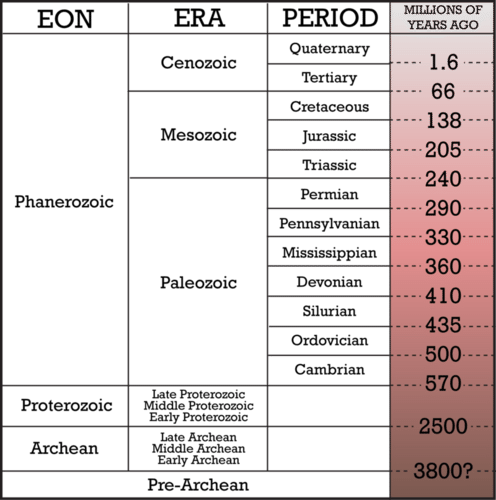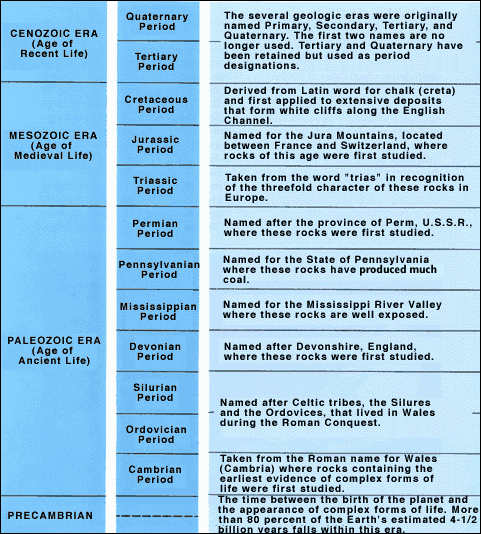Map symbols are in parentheses. The geologic time scale is an important tool used to portray the history of the Eartha standard timeline used to describe the age of rocks and fossils and the events that.

Geologic Time 8th Grade Science
In the time scale shown at left only the two highest levels of this hierarchy are represented.

. An Epoch lasts several million years. The division dates of the various eons eras periods epochs and ages are based on a range of event types. What is the importance of geologic time scale.
Geological Time Scale is organised into 5 subgroups. Periods are combined to make a. The second largest division of geologic time.
Eons Eras Periods Epochs and Ages. An epoch is a division of a geologic period. The smallest division on the geologic time scale.
Geologists have divided the history of the Earth into a series of time intervals. Which division on the geologic time scale is the shortest quizlet. How geological time scale is divided.
The time scale was developed through the study and observation of layers of rock and relationships as well as. The geologic time scale provides geologists the world over with a shared time reference. Epochs are then divided into ages which are the shortest division of geologic time.
The Phanerozoic Eon is the current geologic eon in the geologic time scale and the one during which abundant animal and plant life has existed. Earliest Eon is known as Hadean followed by the Archaean eon Proterozoic eon and then Phanerozoic Eon. Periods are combined to make a subdivision called an era.
You might say that the geologic time scale is to geoscientists what the periodic table of elements is to chemists. The smallest division of geological time scale is. Chronologically epochs are grouped together into larger units called periods.
The geologic time scale was developed after scientists observed changes in the fossils going from oldest to youngest sedimentary rocks. What is the smallest division of geologic time. From largest division of geologic time to smallest.
Geological Survey Geologic Names Committee 2010. Eon era period epoch. An epoch is a division of a geologic period.
Eons is the largest in the GTS. 121 rows The geologic time scale GTS is a system of chronological dating that classifies geological strata stratigraphy in timeIt is used by geologists paleontologists and other Earth scientists to describe the timing and relationships of events in geologic history. Together the Paleogene and Neogene are also known as the Tertiary T and Quaternary 26 MYA-present.
The geologic time scale is divided into eons eras periods epochs and ages with eons being the longest time divisions and ages the shortest. An eon is the largest division of geological time. The major divisions with brief explanations of each are shown in the following scale of relative geologic time which is arranged in chronological order with the oldest division at the bottom the youngest at the top.
Chronologically epochs are grouped together into larger units called periods. What could be the reason why the geologic time scale was divided into 4 time intervals. Which is the smallest division of geologic time scale.
PG Neogene 230-26 MYA. Each period spans a length of tens to one hundred million years. This is the smallest unit of geologic time.
It is the smallest division of geologic time lasting several million years. The geologic time scale is divided into eons eras periods epochs and ages with eons being the longest time divisions and ages the shortest. Precambrian is the longest and Cenozoic is the shortest.
What was the largest division of time. An eon the largest division of the geologic time scale spans hundreds to thousands of millions of years. Divisions of Geologic Time approved by the US.
The third largest second smallest division of geologic time. This is the smallest unit of geologic time. Eons are divided into Eras which are further subdivided into Periods Epochs and Ages.
What is the smallest division of the geologic time scale. Ages also referred to as stages are the smallest units of geologic time and are usually only a few million years in length. The chart shows major chronostratigraphic and geochronologic units.
The geologic time scale conceptually consists of periods that we break down into smaller epochs. An epoch is the smallest unit of time on the scale but still encompasses a period of millions of years. The Cenozoic Era is split into three periods organized from oldest to youngest and including the geologic map symbol used in the GRI GIS data.
What are the smallest divisions of geologic time. The largest division on the geologic time scale. It reflects ratified unit names and boundary estimates from the International Commission on Stratigraphy Ogg 2009.
It is the smallest division of geologic time lasting several million years. An Epoch lasts several million years. Eons or Eonothems are the largest division of time lasting thousands of millions of years.
What is the smallest division of time called. It covers 541 million years to the present and it began with the Cambrian Period when animals first developed hard shells preserved in. Next there are 34 defined epochs which generally last for tens of millions of years.
Therefore the next smaller division of geologic time coming after an era is a period. How is geologic time scale determined. Epochs An epoch is the smallest unit of time on the scale but still encompasses a period of millions of years.
How the division dates are decided. The present age is the Meghalayan. The geologic time scale is divided into several magnitudes of units of time.
Major Divisions of Geologic Time.

Geologic Time Geologic Time Scale Spans 4 5 Billion Years Ppt Video Online Download

0 Comments